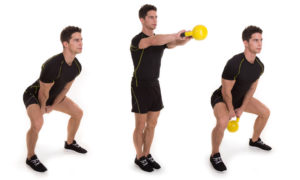
Power Up Your Workout with Kettlebell Swings
Workouts should not be repetitive or monotonous. With so many ways to build strength and boost your cardiovascular health, boredom should never be an issue. Working with weights builds strength but adding kettlebells to your workout builds power capabilities as well. So, get ready to power up your workouts and get into the swing of things with kettlebells.
What is a kettlebell?
It’s a ball, usually made of metal, that has a handle on the top. It was the Russians who first introduced kettlebells in the late 1800s. How do you use them? You grip the handle of the kettlebell and use it to do an array of exercises, including kettlebell swings. Kettlebells come in weights that range from 2 pounds to almost 200 pounds. It’s best, to begin with, a light kettlebell and master kettlebell form before moving up to a heavier weight. Many kettlebell movements are dynamic and require careful attention to form to avoid injury.
How to Do a Kettlebell Swing
The classic kettlebell exercise is the kettlebell swing. The exercise is basic enough, but it takes practice to do it correctly. Here’s how to do one:
• Stand with your feet hip-width apart. The kettlebell should be on the floor midway between your two feet.
• Squat down as if descending into a squat and grab the kettlebell handle with both hands. Your palms should point toward you when you grip the handle.
• Stand up straight as you hold the kettlebell with two hands.
• Shift your weight on to your heels and lower your buttocks back behind you while holding the kettlebell.
• Hinge your hips forward as you swing the kettlebell into the air with straight arms. The kettlebell should reach about chest height.
• Let the weight fall back down through your legs as you shift your body weight back toward your heels.
• Repeat.
What about form?
Some people have a problem with the hip hinge portion of a kettlebell swing. With a proper hip hinge, you move your buttocks back while keeping your knees in place. A common mistake is to bend the knees too much and turn a hip hinge into a squat. Your hips should power the movement. One benefit of kettlebell swings is it helps you master the hip hinge movement. That’s important if you play sports and if you do other weight training exercises, such as squats and deadlifts.
Other Benefits of Swinging a Kettlebell
Working with weights builds strength, but unless you lift the weight at a fast tempo, you won’t boost your body’s ability to generate power. Unlike strength training where you produce force at a slow, controlled rate, power is generating force quickly, and you need the ability to do that. Power is what makes it possible to jump up out of a chair. Frail, elderly people become wheelchair-bound not just because they lack strength, but they can’t unleash enough power to push themselves out of a chair. Kettlebells, because they’re a dynamic exercise that uses resistance and helps you become more powerful. A study published in The Journal of Strength and Conditioning Research found that 56 weeks of twice-weekly kettlebell training build explosive strength and power and determined it’s a highly effective form of training for athletes.
Kettlebell swings get your heart rate up too. Unlike moderate-intensity, steady-state exercise, like running or jogging, kettlebell swings tap into anaerobic energy pathways. This exercise gives you greater ability to sustain short, intense bursts of exercise. In fact, a University of Wisconsin at La Crosse study showed kettlebell training rivals the intensity of running a six-minute mile. Because you partially use anaerobic pathways when you swing a kettlebell, you get more of an after-burn than steady-state exercise provides. So, you burn more calories after a kettlebell session is over.
In addition, kettlebell swings work multiple muscle groups, including the muscles in your lower body, upper body, and core. Few exercises work so many muscle groups, with the exception of a deadlift, and kettlebell swings are more dynamic than deadlifts. Doing kettlebell swings works the stabilizing muscles in your core and can help prevent lower back pain and improve posture.
The Bottom Line
Kettlebell swings is an exercise you need in your workout, especially if your workout could use more variety and you want to improve your performance in sports that require power. Swings are only one exercise you can do with kettlebells. So, investing in a few pairs is worth it when you consider how versatile these balls of metal are.
References:
ACE Fitness. “Kettlebells: Twice the Results in Half the Time?”
Stack.com. “Master the Hip Hinge, Exercise’s Most Important Motion
The Journal of Strength and Conditioning Research. “Oxygen Cost of Kettlebell Swings”
Strength Cond Res. 2012 Aug;26(8):2228-33. doi: 10.1519/JSC.0b013e31825c2c9b.
